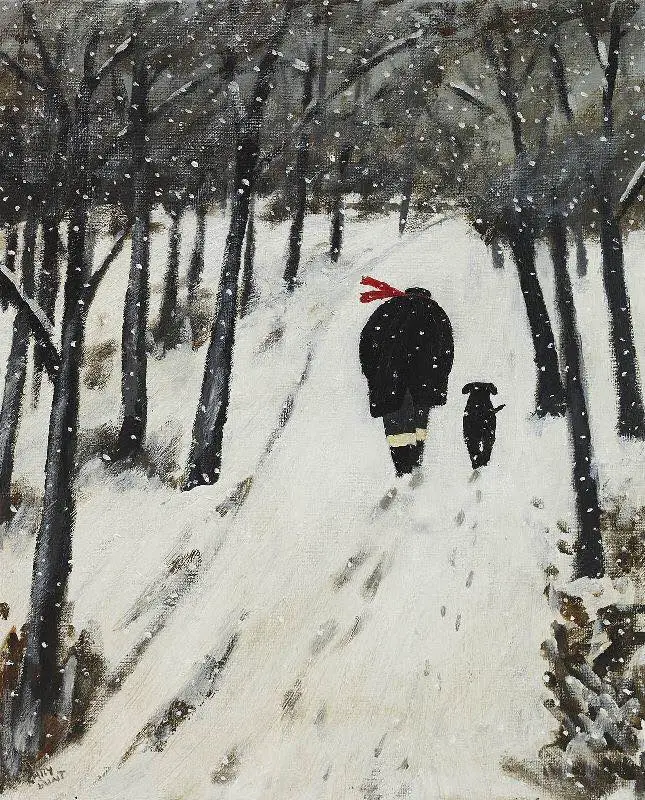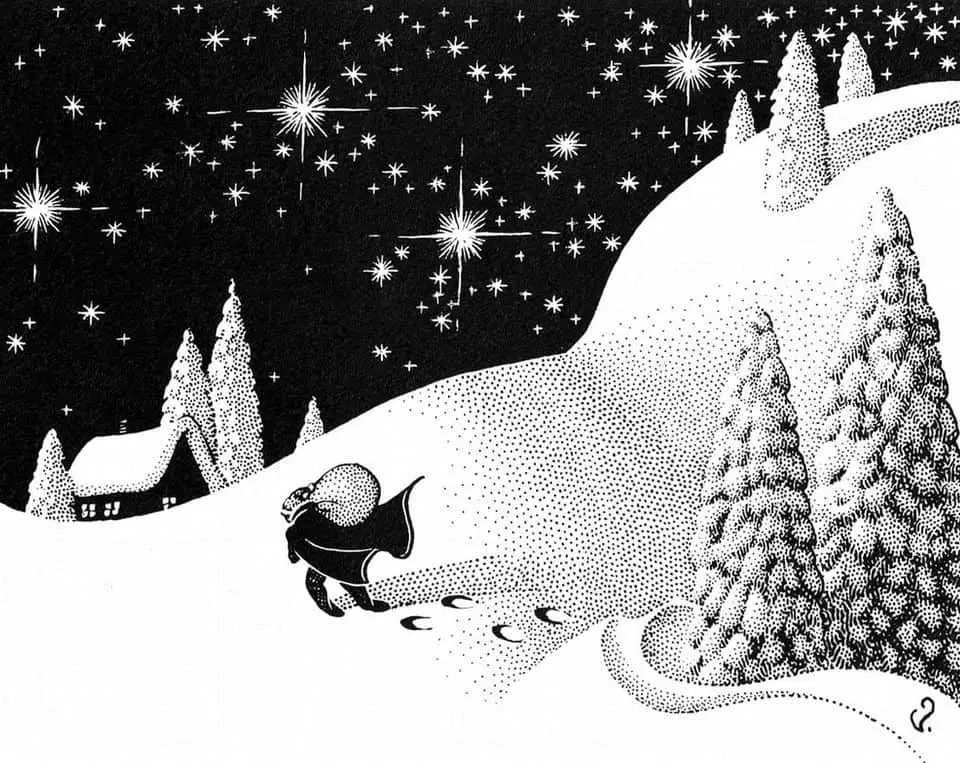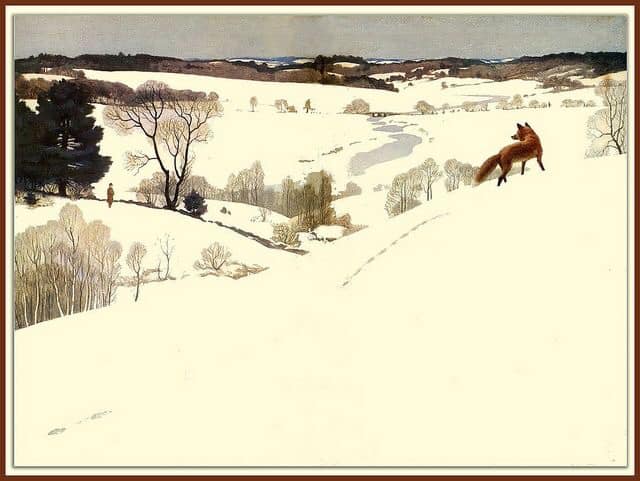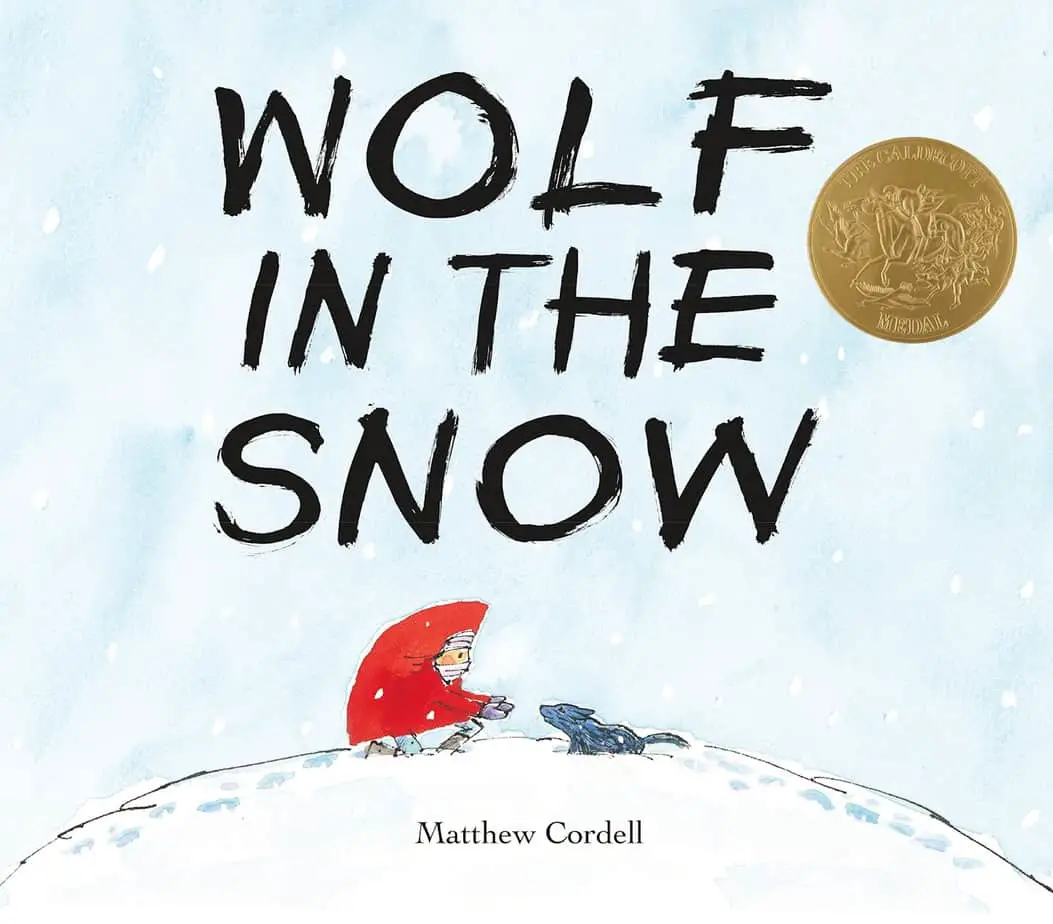Wolf in the Snow (2017) is an almost wordless picture book written and illustrated by Matthew Cordell, with links to the Little Red Riding Hood fairy tale.
All picturebooks are puzzles. The details of pictures invite attention to their implications. The unmoving pictures require viewers to solve the puzzle of what actions and motions they represent. The pictures in wordless books require viewers to solve the puzzle of what story they imply. In books with texts, the words and pictures together tell different stories that require readers to solve the puzzle of how to connect them. The pleasure of picture books is not just in the stories they tell but also in the game of figuring out what those stories are.
The Pleasures of Children’s Literature, Nodelman and Reimer

STRUCTURE OF WOLF IN THE SNOW
Wolf in the Snow is a mythic journey in which a main character travels a long/treacherous path, meets a variety of opponents and allies, comes close to death then makes it home (or sometimes finds a new home). The path in this case is the journey between school and home one snowy afternoon.
This is slightly different from your classic adventure story as described (and critiqued) by Marjery Hourihan. This is an example of a modern female myth. How are female myths different from hero myths? There is no traditional ‘battle’ scene and the characters think and feel their way out of trouble. Wolf in the Snow is the perfect example of a so-called female myth.
Female myths also tend to be more about co-operation than about individual heroes saving the world. The mirrored motifs of this picture book exemplify the spirit of loving co-operation.
Let’s call it a parallel story structure.
PARATEXT
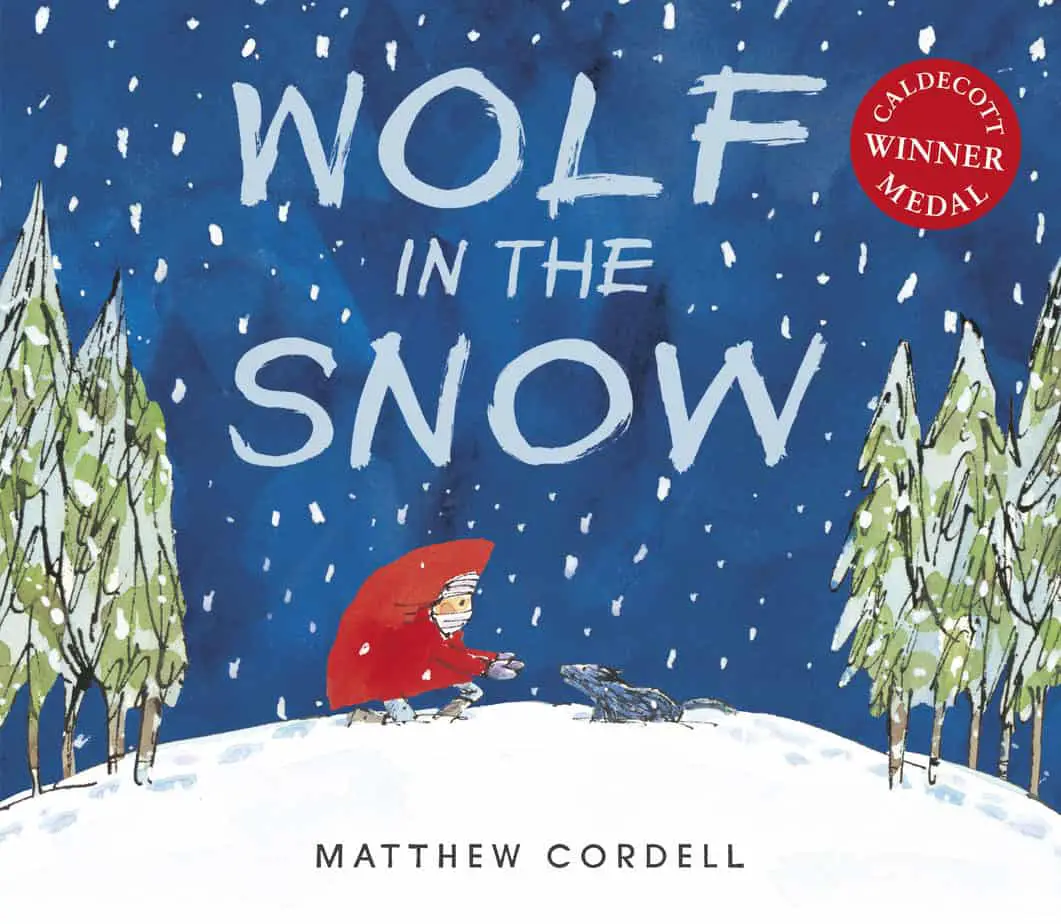
A girl is lost in a snowstorm. A wolf cub is lost, too. How will they find their way home?
Paintings rich with feeling tell this satisfying story of friendship and trust. Here is a book set on a wintry night that will spark imaginations and warm hearts, from Matthew Cordell, author of Trouble Gum and Another Brother.
MARKETING COPY
There’s an Easter Egg under the dust cover of the hardback version of Wolf In The Snow — a series of vignettes that are not from the main story.
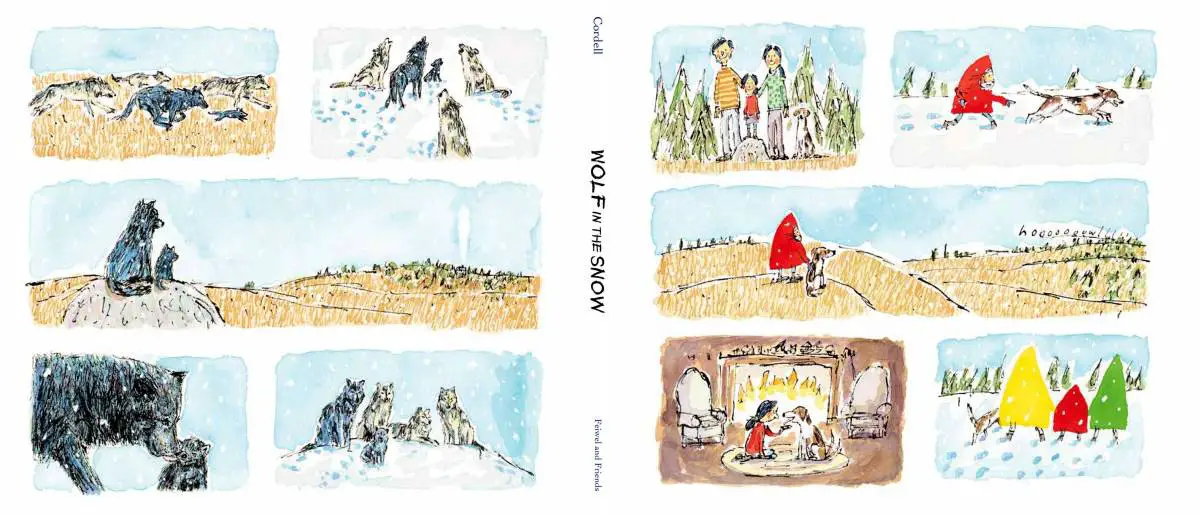
SHORTCOMING
The girl is dressed in a bright red coat, which will always put readers in mind of Little Red Riding Hood, even more so when she goes into a forest.
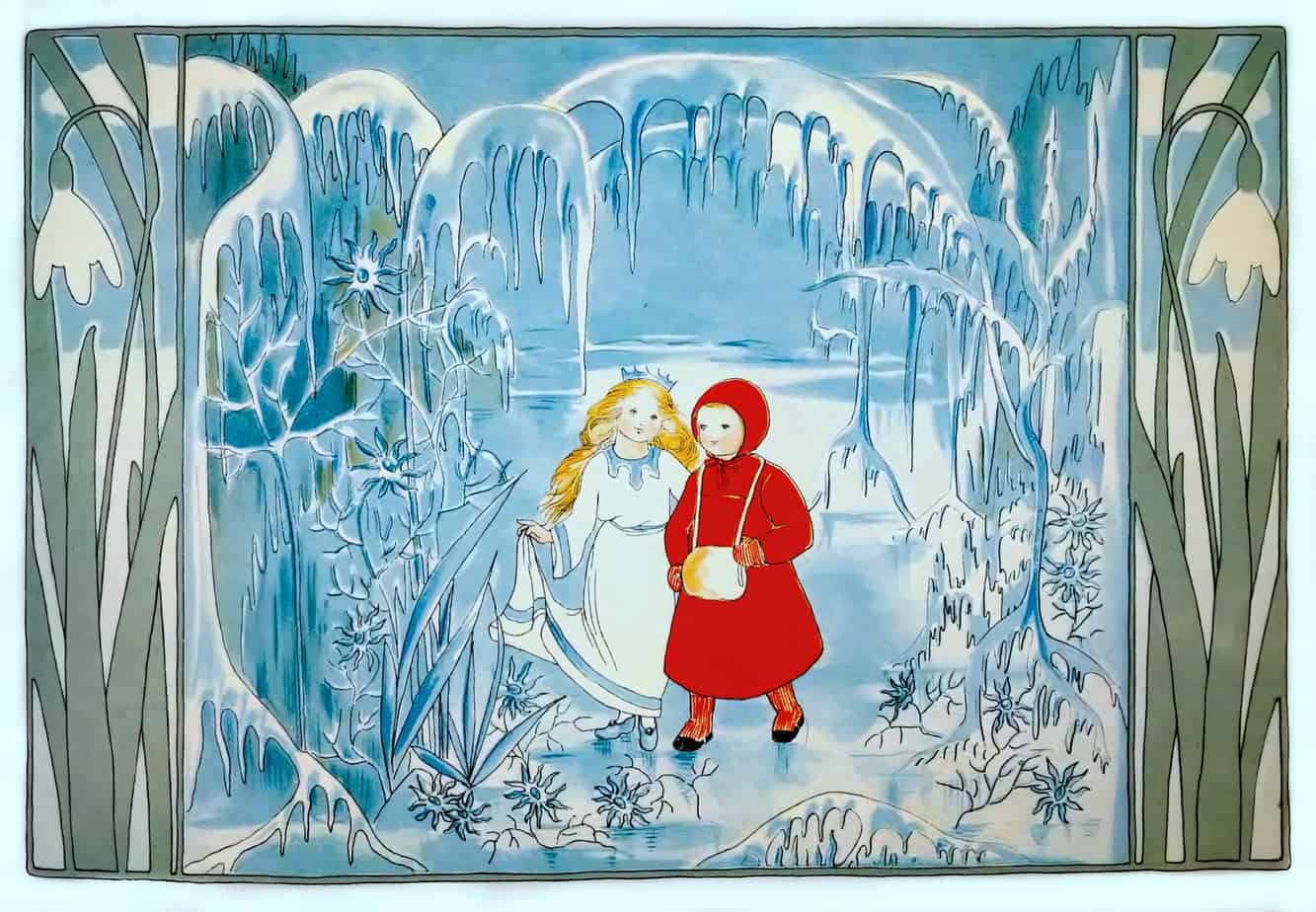
The forest is a metaphor for one’s darkest psychology. More so again when she meets a wolf in the forest. This story is clearly a take on the classic fairy tale.
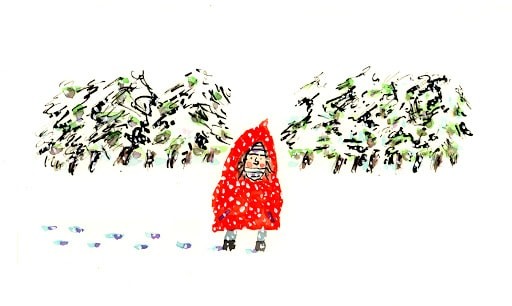
The other story is that of the wolf pup who can’t keep up with the adults and is accidentally left behind during the snow blizzard.
DESIRE
When Little Red Riding Hood finds an abandoned pup she wants to reunite the pup with its pack. We have previously been shown that Red Riding Hood has a dog at home, and we can deduce this gives her a special affinity with canine creatures.
The pup, we can easily intuit, wants to be reunited with its own pack.
OPPONENT
For a Western-style picture book, the reader moves from left to right through the pages. Any scene in which characters face the other way carry meaning. In this case, the wolves are heading towards Little Red Riding Hood. They are also depicted realistically, unlike the more cartoonish Little Red Riding Hood. This makes them more scary. (More real equals more scary.) We can see their breath, which might double for ferocious panting.
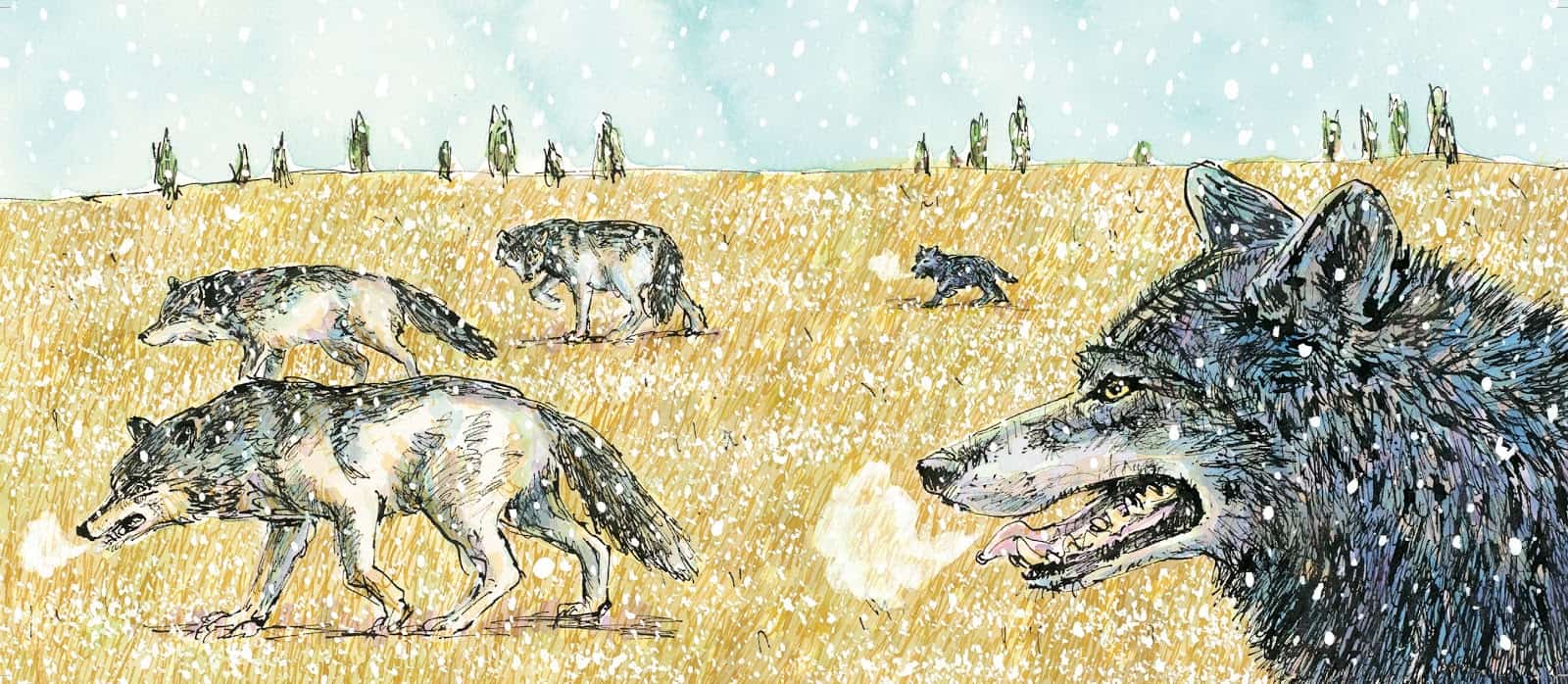
Girl and wolf will soon come face to face. This entire storybook creates a mirror reflection in a number of ways.
- The opening view through the window into the house; closing with the same view
- In the window view, the girl and dog face each other; above, mother and father face each other.
- The school on one side, the home on the other, with a book full of two page spreads in which the reader sees (or at least feels) the beginning and end of the journey in one view.
- The girl moves from left to right on her journey; the wolves move from right to left.
- The girl helps the wolves; the wolves help the girl in the exact same way — helping her get back to her family.
- At times the view of the scene is behind a screen of some kind. We have the window example above, but also the view through binoculars — the scene contrained via circles (coded as binoculars). Who is watching the scene through binoculars? The audience? Or the wolves? Either way, this creates a mirror effect of one character looking back at the other, with the underlying theme that when you look in a mirror you’re looking back at someone the same as yourself. The frame of the ‘binocular’ also creates a frame around Little Red Riding Hood and wolves, who are yet to meet. This framing technique serves at least double duty.
PLAN
Little Red Riding Hood meets a wolf in the forest, but this is an inversion of the fairy tale: the wolf is a pup, and instead of trying to trick her, the pup requires her help. Little Red Riding Hood plans to walk around until she finds the pup’s pack. Eventually she hears the wolves howling.
THE BIG STRUGGLE
Eventually Little Red Riding Hood comes face to face with a fearsome creature.
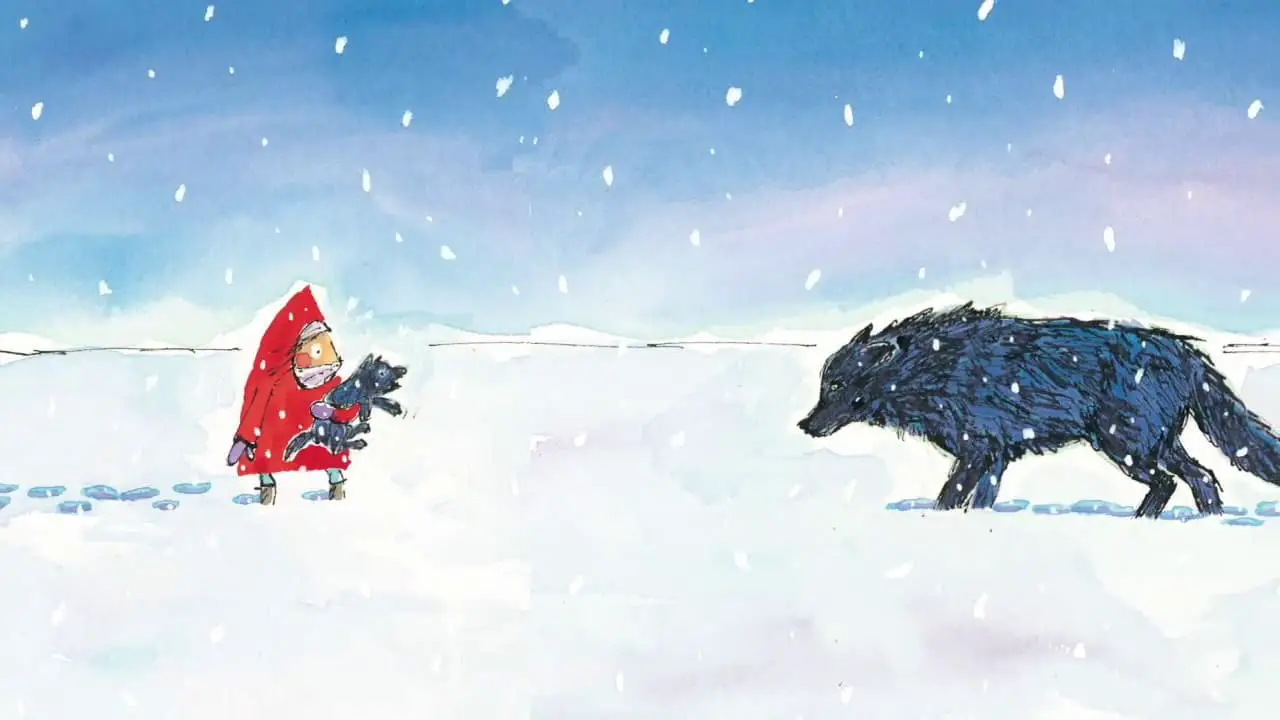
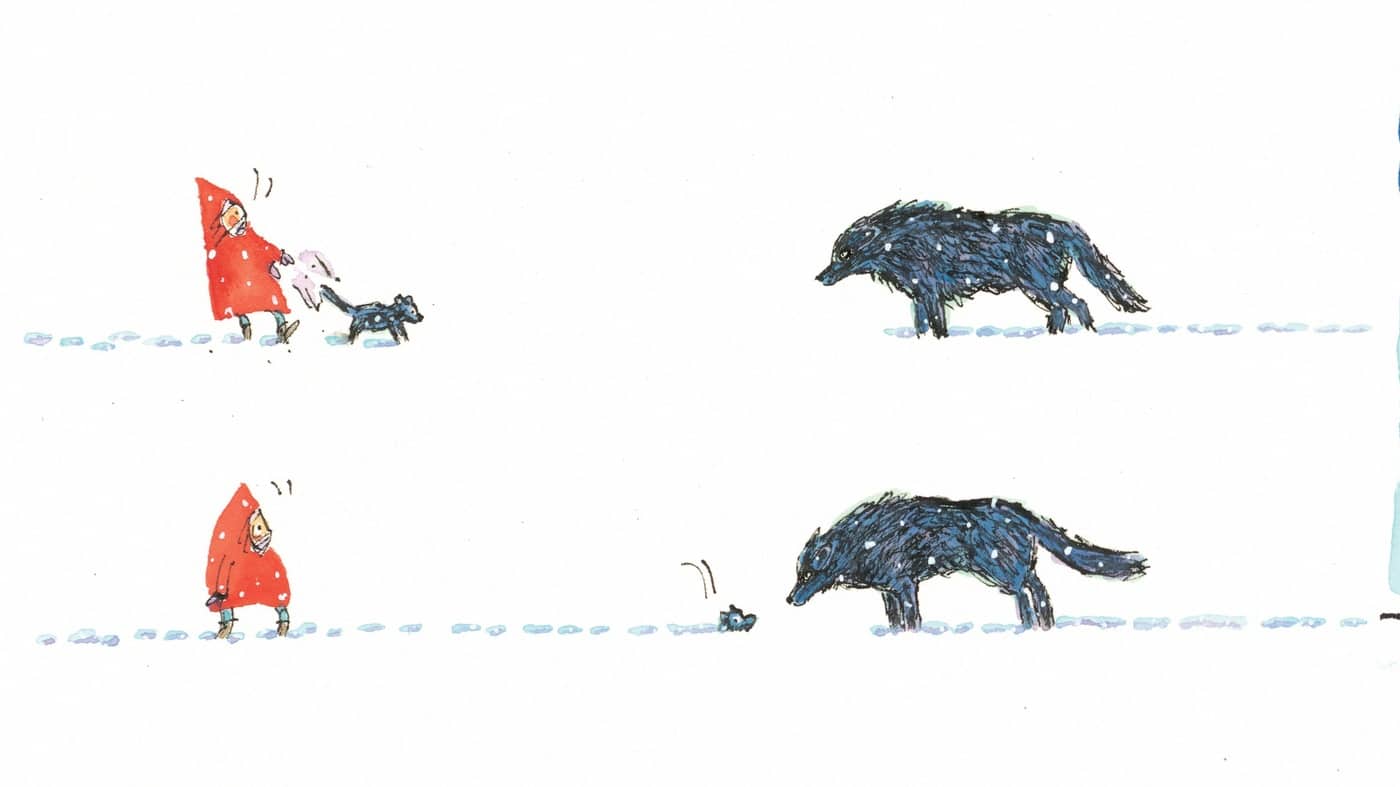
Where else have we seen a girl and an animal come face to face? The same one point perspective is a central image of The Fog, another picture book about cooperation between humans and wild animals. Likewise, the pair come at each other from opposite sides of the book. Also similar: the girl wears a red coat, though in The Fog the Little Red Riding Hood motif begins and ends with the coat.
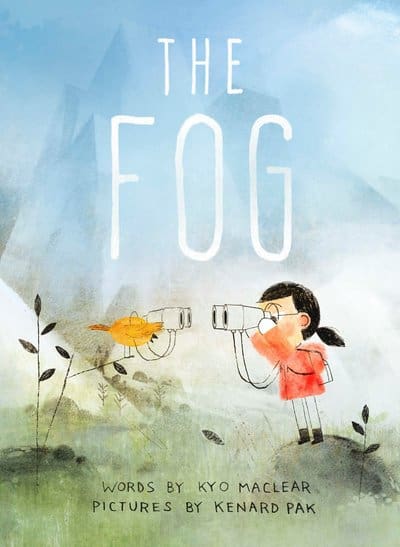
The covers of Japanese magazine Ukatama also make use of the motif of the little girl in the red coat and also her wolf.
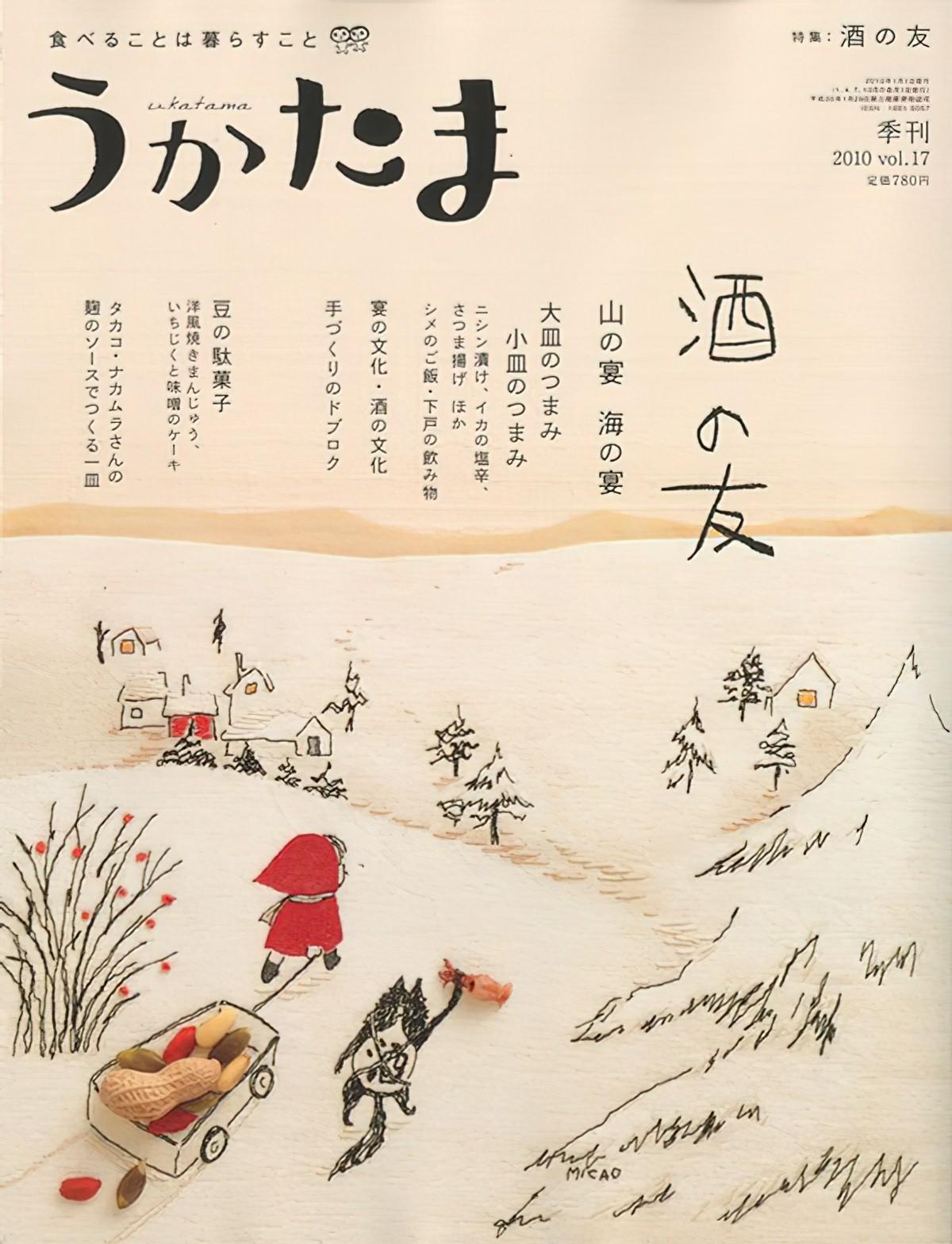
In Wolf In The Snow, Red Riding Hood comes close to death when she gets lost in the woods, lies down and curls up, as if ready to give up.
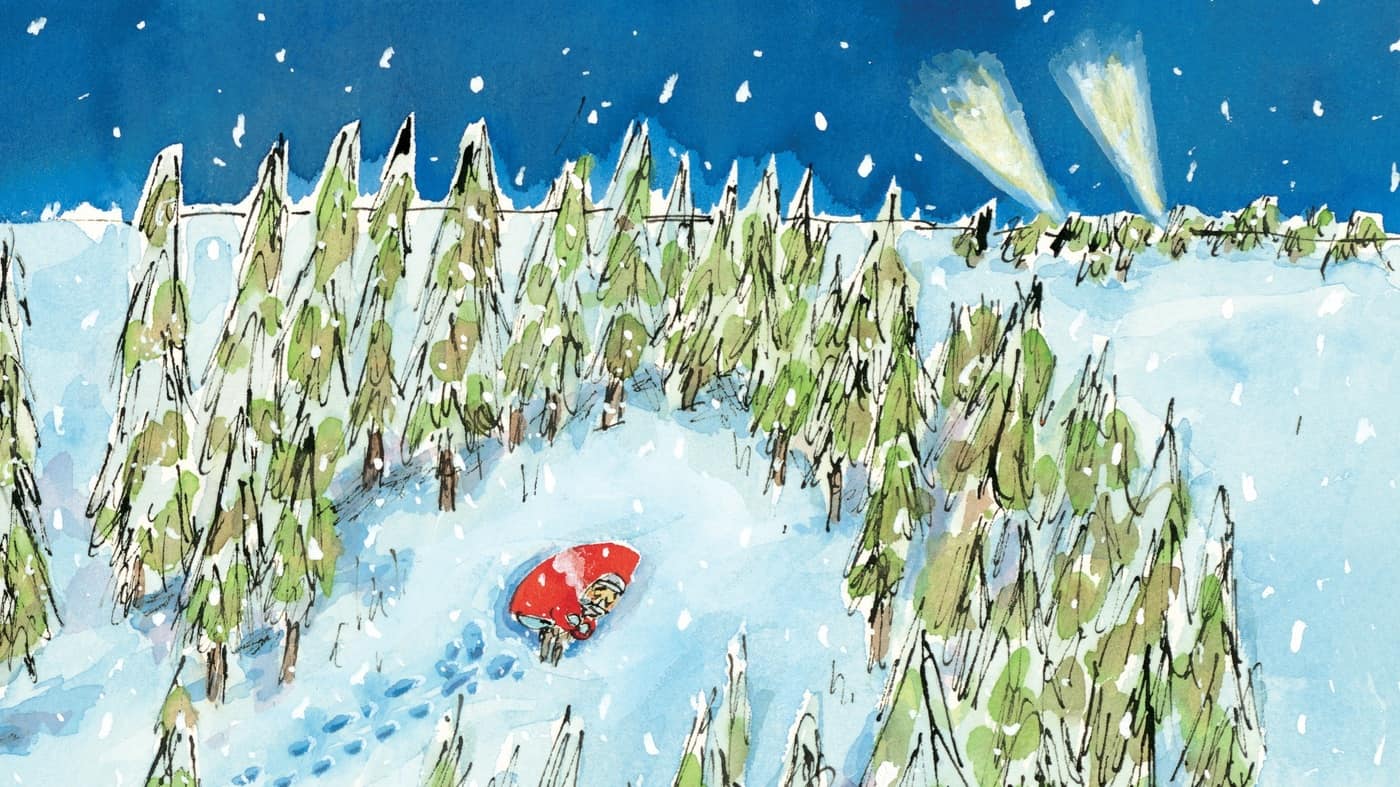
I’m reminded of the Japanese illustration below.
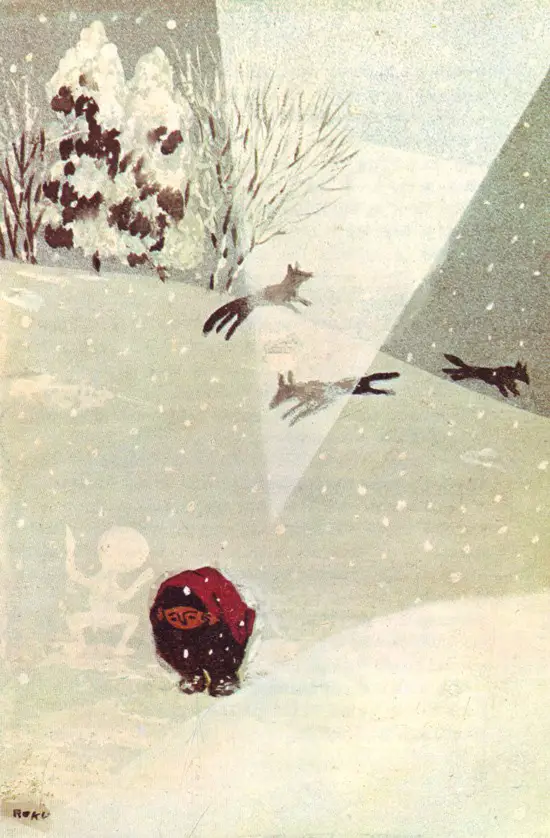
Now the wolves formulate a plan to help Little Red Riding Hood. They will howl until her parents are alerted. The dog comes in useful for practical reasons — the dog is able to track to the wolves who — in a witchlike scene — form a circle around the lost girl.
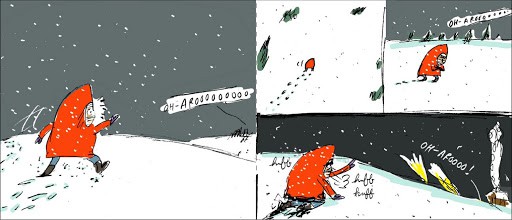
ANAGNORISIS
Little Red Riding Hood works out what the wolves are doing. So she gets up and continues on home.
NEW SITUATION
Red Riding Hood is safe again at home.
EXTRAPOLATED ENDING
Thematically, the idea that humans and animals are equal is prevalent in modern picture books. I’m noticing the main characters of these man-meets-nature books are tending to be female (though not always). There is definitely a stereotypically feminine sensibility that shines through in stories that are essentially about co-operation. In these co-operation stories, the potential opponent turns out to be an ally.
Fewer characters are needed when the opponent and ally are the same. These female myths tend to quite pared down as a result. These stories are not about fighting and conflict; they are about thinking and feeling one’s way out of a problem. That said, don’t mistake these stories for low stakes. The characters still come close to death, often due to environmental causes rather than individual villains.
RESONANCE
There will always be takes on Little Red Riding Hood because the fairytale speaks to us at such a deep level.
FOR FURTHER INVESTIGATION
Lotta: Red Riding Hood is my own Little Red Riding Hood revisioning but for older readers. Also set in the snow, also featuring red as an accent colour.
If you enjoyed Matthew Cordell’s illustrations in Wolf In The Snow, you may like to check out British artist Gary Bunt.
